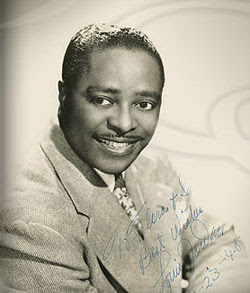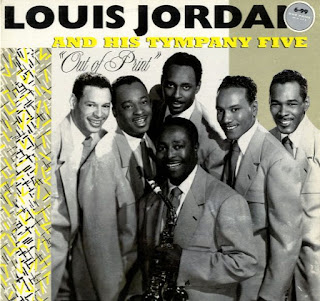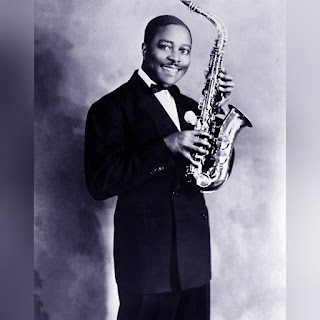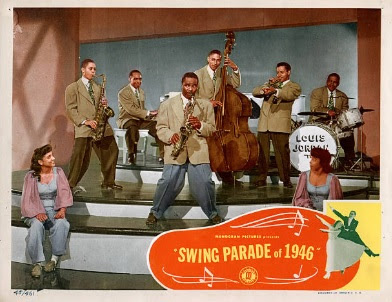Louis Thomas Jordan (July 8, 1908 – February 4, 1975) was an American musician, songwriter and bandleader who was popular from the late 1930s to the early 1950s. Known as "The King of the Jukebox", his highest profile came towards the end of the swing era. His pioneering use of jumping shuffle rhythms in a small combo context was copied far and wide during the 1940s.
 The son of a musician, Jordan spent time as a youth with the Rabbit Foot Minstrels and majored in music later on at Arkansas Baptist College. After moving with his family to Philadelphia in 1932, Jordan hooked up with pianist Clarence Williams. He joined the orchestra of drummer Chick Webb in 1936 and remained there until 1938. Having polished up his singing abilities with Webb's outfit, Jordan was ready to strike out on his own.
The son of a musician, Jordan spent time as a youth with the Rabbit Foot Minstrels and majored in music later on at Arkansas Baptist College. After moving with his family to Philadelphia in 1932, Jordan hooked up with pianist Clarence Williams. He joined the orchestra of drummer Chick Webb in 1936 and remained there until 1938. Having polished up his singing abilities with Webb's outfit, Jordan was ready to strike out on his own. The saxophonist's first 78 for Decca in 1938, "Honey in the Bee Ball," billed his combo as the Elks Rendezvous Band (after the Harlem nightspot that he frequently played at). From 1939 on, though, Jordan fronted the Tympany Five, a sturdy little aggregation often expanding over quintet status that featured some well-known musicians over the years: pianists Wild Bill Davis and Bill Doggett, guitarists Carl Hogan and Bill Jennings, bassist Dallas Bartley, and drummer Chris Columbus all passed through the ranks.
The saxophonist's first 78 for Decca in 1938, "Honey in the Bee Ball," billed his combo as the Elks Rendezvous Band (after the Harlem nightspot that he frequently played at). From 1939 on, though, Jordan fronted the Tympany Five, a sturdy little aggregation often expanding over quintet status that featured some well-known musicians over the years: pianists Wild Bill Davis and Bill Doggett, guitarists Carl Hogan and Bill Jennings, bassist Dallas Bartley, and drummer Chris Columbus all passed through the ranks. From 1942 to 1951, Jordan scored an astonishing 57 R&B chart hits (all on Decca), beginning with the humorous blues "I'm Gonna Leave You on the Outskirts of Town" and finishing with "Weak Minded Blues." In between, he drew up what amounted to an easily followed blueprint for the development of R&B (and for that matter, rock & roll -- the accessibly swinging shuffles of Bill Haley & the Comets were directly descended from Jordan; Haley often pointed to his Decca labelmate as profoundly influencing his approach).
From 1942 to 1951, Jordan scored an astonishing 57 R&B chart hits (all on Decca), beginning with the humorous blues "I'm Gonna Leave You on the Outskirts of Town" and finishing with "Weak Minded Blues." In between, he drew up what amounted to an easily followed blueprint for the development of R&B (and for that matter, rock & roll -- the accessibly swinging shuffles of Bill Haley & the Comets were directly descended from Jordan; Haley often pointed to his Decca labelmate as profoundly influencing his approach)."G.I. Jive,""Caldonia,""Buzz Me,""Choo Choo Ch' Boogie,""Ain't That Just like a Woman,""Ain't Nobody Here but Us Chickens,""Boogie Woogie Blue Plate,""Beans and Cornbread,""Saturday Night Fish Fry," and "Blue Light Boogie"
-- every one of those classics topped the R&B lists, and there were plenty more that did precisely the same thing. Black audiences coast-to-coast were breathlessly jitterbugging to Jordan's jumping jive (and one suspects, more than a few whites kicked up their heels to those same platters as well).
-- every one of those classics topped the R&B lists, and there were plenty more that did precisely the same thing. Black audiences coast-to-coast were breathlessly jitterbugging to Jordan's jumping jive (and one suspects, more than a few whites kicked up their heels to those same platters as well).
The saxophonist was particularly popular during World War II. He recorded prolifically for the Armed Forces Radio Service and the V-Disc program. Jordan's massive popularity also translated on to the silver screen -- he filmed a series of wonderful short musicals during the late '40s that were decidedly short on plot but long on visual versions of his hits (Caldonia, Reet Petite & Gone, Look Out Sister, and Beware, along with countless soundies) that give us an
![]() enlightening peek at just what made him such a beloved entertainer. Jordan also cameoed in a big-budget Hollywood wartime musical, Follow the Boys.
enlightening peek at just what made him such a beloved entertainer. Jordan also cameoed in a big-budget Hollywood wartime musical, Follow the Boys.
 enlightening peek at just what made him such a beloved entertainer. Jordan also cameoed in a big-budget Hollywood wartime musical, Follow the Boys.
enlightening peek at just what made him such a beloved entertainer. Jordan also cameoed in a big-budget Hollywood wartime musical, Follow the Boys.In the 50s, even even though his singles were still eminently solid, they weren't selling like they used and so after an incredible run of more than a decade-and-a-half, Jordan moved over to the Aladdin label. However, the sound was no longer what young R&B fans were searching for at the time.
However, in 1956 a fine Quincy Jones-arranged date for Mercury deftly updated Jordan's classics for the rock & roll crowd, the whole session benefiting from the lead guitar of Mickey Baker and Sam Taylor's muscular tenor sax.
However, in 1956 a fine Quincy Jones-arranged date for Mercury deftly updated Jordan's classics for the rock & roll crowd, the whole session benefiting from the lead guitar of Mickey Baker and Sam Taylor's muscular tenor sax.
Ray Charles had long cited Jordan as a primary influence (he lovingly covered Jordan's 'Don't Let the Sun Catch You Crying' and 'Early in the Morning'), and paid him back by signing Jordan to the Genius' Tangerine label. Once again, the record buyers ignored his worthwhile 1962-64 offerings, which were by any standards still very fine recordings. Throughout the 60s and early 70s, Jordan worked only sporadically anyway as his health deteriorated and made performing regularly an impossibility.
A heart attack silenced this visionary in 1975, but not before he acted as the bridge between the big-band era and the rise of R&B. His profile continues to rise posthumously, in large part due to the acclaimed musical from Clarke Peters called "Five Guys Named Moe", based on Jordan's bubbly persona and, more importantly, on some of his great songs.
A heart attack silenced this visionary in 1975, but not before he acted as the bridge between the big-band era and the rise of R&B. His profile continues to rise posthumously, in large part due to the acclaimed musical from Clarke Peters called "Five Guys Named Moe", based on Jordan's bubbly persona and, more importantly, on some of his great songs.
On June 25, 2019, The New York Times Magazine listed Louis Jordan among hundreds of artists whose material was reportedly destroyed in the 2008 Universal fire.
(Info edited mainly from AllMusic & rhythm and the blues.org.uk)




